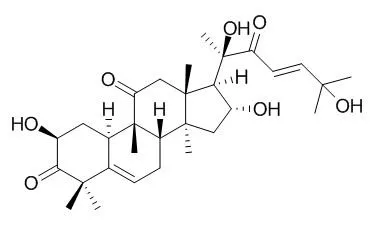| In vitro: |
| Int Immunopharmacol. 2013 Dec;17(4):1044-50. | | Cucurbitacin D is a new inflammasome activator in macrophages.[Pubmed: 24140411] | We previously reported that Cucurbitacin D isolated from Trichosanthes kirilowii has anti-tumor roles to leukemia cells. However, the effect of Cucurbitacin D on immune cells is not fully understood although there is no toxic activity to normal cells.
METHODS AND RESULTS:
In this study, immunomodulating activities of Cucurbitacin D were investigated in macrophages. Cucurbitacin D could increase LPS-induced interleukin (IL)-1β production in culture supernatant of THP-1 cells, peritoneal exudate cells (PECs), bone marrow derived macrophages (BMDMs), and RAW264 cells. At the transcriptional level, Cucurbitacin D enhanced LPS-induced IL-1β mRNA expression through activation of ERK1/2 mitogen-activated protein kinases (MAPKs). At the posttranscriptional level, the activation of caspase-1 induced by Cucurbitacin D has also been demonstrated following treatment with a caspase-1 inhibitor and siRNA. Importantly, Cucurbitacin D has further been shown to induce inflammasome activation independent of ERK1/2 activation. Western blotting showed interaction of NOD-like receptor family, pyrin domain containing 3 (NALP3) and apoptosis-associated speck-like protein containing a caspase-activating and recruitment domain (ASC), suggesting activation of the inflammasome and a possible reason for activation of caspase-1.
CONCLUSIONS:
Taken together, these results suggest that Cucurbitacin D could initiate immunomodulating activity in macrophages to lead to inflammasome activation as well as enhancement of LPS signaling. | | Anticancer Res. 2014 Sep;34(9):4797-806. | | Cucurbitacin-D-induced CDK1 mRNA up-regulation causes proliferation arrest of a non-small cell lung carcinoma cell line (NSCLC-N6).[Pubmed: 25202060] | Despite progress in chemotherapeutic agents, non-small cell lung cancers (NSCLC) still have a poor survival rate. Thus, development of new therapeutic strategies, specifically against cancer cells is still required.
METHODS AND RESULTS:
For this purpose, we treated the non-small cell lung cancer cell line NSCLC-N6 with the natural product Cucurbitacin D (CucD) - extracted from the plant Ecballium elaterium in order first to assess its in vitro cytotoxicity, but also to study the genetic changes that it could bring out. Cucurbitacin D has shown a blocking in the G1 phase of the cell cycle in NSCLC-N6 cells prior to apoptotic cell death. The reverse transcriptase-polymerase chain reaction-differential display (RT-PCR-DD) technique was also applied on treated cells to elucidate the genetic mechanisms involved. We revealed an overexpression of Cyclin-dependent kinase 1 (CDK1) mRNA after treatment and, with the use of antisense oligonucleotides, an effective role in the proliferation arrest of NSCLC-N6 cells.
CONCLUSIONS:
The present study provides new insights about the mechanisms of proliferation arrest in tumor cells and open new ways of treatment to target tumor growth. | | Int Immunopharmacol. 2009 Apr;9(4):508-13. | | Cucurbitacin D isolated from Trichosanthes kirilowii induces apoptosis in human hepatocellular carcinoma cells in vitro.[Pubmed: 19185617] | The aim of the present study is to examine the effects of the anti-tumor component isolated from Trichosanthes kirilowii on human hepatocellular carcinoma cells.
METHODS AND RESULTS:
Using Sephadex G-25 column chromatography, Sep-Pak Plus C18 cartridge and high-performance liquid chromatography (HPLC), we isolated the active component from trichosanthes extract. By fast atom bombardment mass spectrometric analysis, the molecular mass of the active fraction was determined, the active components identified, and their mechanisms of action were analyzed by cell growth assay, cell cycle analysis, TUNEL staining and Western blot analysis. We found that the anti-tumor components isolated from the extract of trichosanthes (EOT) are Cucurbitacin D and dihydroCucurbitacin D, and suggest that Cucurbitacin D induces apoptosis through caspase-3 and phosphorylation of JNK in hepatocellular carcinoma cells.
CONCLUSIONS:
These results suggest that Cucurbitacin D isolated from Trichosanthes kirilowii could be a valuable candidate for anti-tumor drug. |
|
| In vivo: |
| Blood Cells Mol Dis. 2010 Dec 15;45(4):269-75. | | Cucurbitacin D induces fetal hemoglobin synthesis in K562 cells and human hematopoietic progenitors through activation of p38 pathway and stabilization of the γ-globin mRNA.Cucurbitacin D induces fetal hemoglobin synthesis in K562 cells and human hematop[Pubmed: 20926322] | The search for novel therapeutic candidates targeting fetal hemoglobin (HbF) activation to reduce the imbalance of globin genes is regarded as a promising approach for the clinical management of sickle cell disease and β-thalassemia.
METHODS AND RESULTS:
For the first time, we identified Cucurbitacin D (CuD), an oxygenated tetracyclic triterpenoid, as a molecular entity inducing γ-globin gene expression and HbF synthesis in K562 cells and human hematopoietic progenitors from a β-thalassemia patient. Cucurbitacin D demonstrated a higher potency in HbF induction when compared with hydroxyurea, which was revealed by the evidence that Cucurbitacin D results in a higher fetal cell percentage and greater HbF content in K562 cells, in addition, to being less cytotoxic. Moreover, Cucurbitacin D also promotes higher HbF expression in primary erythroid cells. In the study to elucidate the molecular mechanisms of Cucurbitacin D's action, our data indicated that Cucurbitacin D-stimulated HbF synthesis was mediated by p38 pathway activation. At the post-transcriptional level, Cucurbitacin D treatment led to a significant elongation of the γ-globin mRNA half-life in K562 cells.
CONCLUSIONS:
Taken together, the results suggest that Cucurbitacin D may be a potential therapeutic agent for β-hemoglobinopathies, including sickle cell anemia and β-thalassemia. |
|






 Cell. 2018 Jan 11;172(1-2):249-261.e12. doi: 10.1016/j.cell.2017.12.019.IF=36.216(2019)
Cell. 2018 Jan 11;172(1-2):249-261.e12. doi: 10.1016/j.cell.2017.12.019.IF=36.216(2019) Cell Metab. 2020 Mar 3;31(3):534-548.e5. doi: 10.1016/j.cmet.2020.01.002.IF=22.415(2019)
Cell Metab. 2020 Mar 3;31(3):534-548.e5. doi: 10.1016/j.cmet.2020.01.002.IF=22.415(2019) Mol Cell. 2017 Nov 16;68(4):673-685.e6. doi: 10.1016/j.molcel.2017.10.022.IF=14.548(2019)
Mol Cell. 2017 Nov 16;68(4):673-685.e6. doi: 10.1016/j.molcel.2017.10.022.IF=14.548(2019)